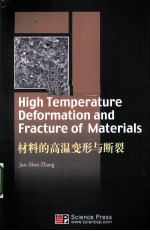图书介绍
材料的高温变形与断裂 英文版PDF|Epub|txt|kindle电子书版本网盘下载

- 张俊善著 著
- 出版社: 北京:科学出版社
- ISBN:9787030275400
- 出版时间:2010
- 标注页数:365页
- 文件大小:17MB
- 文件页数:378页
- 主题词:材料-高温变形-研究-英文;材料-断裂-研究-英文
PDF下载
下载说明
材料的高温变形与断裂 英文版PDF格式电子书版下载
下载的文件为RAR压缩包。需要使用解压软件进行解压得到PDF格式图书。建议使用BT下载工具Free Download Manager进行下载,简称FDM(免费,没有广告,支持多平台)。本站资源全部打包为BT种子。所以需要使用专业的BT下载软件进行下载。如BitComet qBittorrent uTorrent等BT下载工具。迅雷目前由于本站不是热门资源。不推荐使用!后期资源热门了。安装了迅雷也可以迅雷进行下载!
(文件页数 要大于 标注页数,上中下等多册电子书除外)
注意:本站所有压缩包均有解压码: 点击下载压缩包解压工具
图书目录
Part Ⅰ High Temperature Deformation3
1 Creep Behavior of Materials3
1.1 Creep Curve3
1.2 Stress and Temperature Dependence of Creep Rate4
1.3 Stacking Fault Energy Effect9
1.4 Grain Size Effect10
References12
2 Evolution of Dislocation Substructures During Creep14
2.1 Parameters of Dislocation Substructures and Their Measurements14
2.2 Evolution of Dislocation Substructure during Creep16
2.3 Dislocation Substructure of Steady State Creep19
2.4 Inhomogeneous Dislocation Substructure and Long-Range Internal Stress22
References26
3 Dislocation Motion at Elevated Temperatures28
3.1 Thermally Activated Glide of Dislocation28
3.2 Measurement of Internal Stress31
3.3 Climb of Dislocations33
3.4 Basic Equations of Recovery Creep36
3.5 Mechanisms of Recovery37
References38
4 Recovery-Creep Theories of Pure Metals40
4.1 Introduction40
4.2 Weertman Model41
4.3 Models Considering Sub-Boundary42
4.4 Models Based on Dislocation Network47
4.5 Creep Model Based on the Motion of Jogged Screw Dislocation50
4.6 Summary of Recovery Creep Models52
4.7 Soft and Hard Region Composite Model53
4.8 Harper-Dorn Creep58
References66
5 Creep of Solid Solution Alloys69
5.1 Interaction Between Dislocation and Solute Atom69
5.2 Creep Behavior of Solid Solution Alloys72
5.3 Viscous Glide Velocity of Dislocations76
5.4 Creep Controlled by Viscous Glide of Dislocations78
References81
6 Creep of Second Phase Particles Strengthened Materials83
6.1 Introduction83
6.2 Arzt-Ashby Model85
6.3 Creep Model Based on Attractive Particle-Dislocation Interaction88
6.4 Interaction of Dislocation with Localized Particles91
6.5 Mechanisms of Particle Strengthening93
6.6 Grain Boundary Precipitation Strengthening96
References100
7 Creep of Particulates Reinforced Composite Material102
7.1 Creep Behavior of Particulates Reinforced Aluminium Matrix Composites102
7.2 Determination of Threshold Stress104
7.3 Creep Mechanisms and Role of Reinforcement Phase105
References110
8 High Temperature Deformation of Intermetallic Compounds111
8.1 Crystal Structures,Dislocations and Planar Defects111
8.2 Dislocation Core Structure115
8.3 Slip Systems and Flow Stresses of Intermetallic Compounds120
8.4 Creep of Intermetallic Compounds126
8.5 Creep of Compound-Based ODS Alloys133
References136
9 Diffusional Creep139
9.1 Theory on Diffusional Creep139
9.2 Accommodation of Diffusional Creep:Grain Boundary Sliding142
9.3 Diffusional Creep Controlled by Boundary Reaction144
9.4 Experimental Evidences of Diffusional Creep149
References151
10 Superplasticity154
10.1 Stability of Deformation154
10.2 General Characteristics of Superplasticity155
10.3 Microstructure Characteristics of Superplasticity158
10.4 Grain Boundary Behaviors in Superplastic Deformation160
10.5 Mechanism of Superplastic Deformation161
10.6 The maximum Strain Rate for Superplasticity167
References170
11 Mechanisms of Grain Boundary Sliding172
11.1 Introduction172
11.2 Intrinsic Grain Boundary Sliding172
11.3 Extrinsic Grain Boundary Sliding174
References180
12 Multiaxial Creep Models182
12.1 Uniaxial Creep Models182
12.2 Mutiaxial Creep Models183
12.3 Mutiaxial Steady State Creep Model185
12.4 Stress Relaxation by Creep186
References187
Part Ⅱ High Temperature Fracture191
13 Nucleation of Creep Cavity191
13.1 Introduction191
13.2 Nucleation Sites of Cavity192
13.3 Theory of Cavity Nucleation195
13.4 Cavity Nucleation Rate196
References197
14 Creep Embrittlement by Segregation of Impurities199
14.1 Nickel and Nickel-Base Superalloys199
14.2 Low-Alloy Steels202
References205
15 Diffusional Growth of Creep Cavities206
15.1 Chemical Potential of Vacancies206
15.2 Hull-Rimmer Model for Cavity Growth207
15.3 Speight-Harris Model for Cavity Growth211
15.4 The role of Surface Diffusion213
References215
16 Cavity Growth by Coupled Diffusion and Creep217
16.1 Monkman-Grant Relation217
16.2 Beer-Speight Model218
16.3 Edward-Ashby Model221
16.4 Chen-Argon model222
16.5 Cocks-Ashby Model225
References228
17 Constrained Growth of Creep Cavities230
17.1 Introduction230
17.2 Rice Model230
17.3 Raj-Ghosh Model233
17.4 Cocks-Ashby Model235
References238
18 Nucleation and Growth of Wedge-Type Microcracks239
18.1 Introduction239
18.2 Nucleation of Wedge-Type Cracks240
18.3 The Propagation of Wedge-Type Cracks242
18.4 Crack Growth by Cavitation244
References246
19 Creep Crack Growth247
19.1 Crack-Tip Stress Fields in Elastoplastic Body247
19.2 Stress Field at Steady-State-Creep Crack Tip251
19.3 The Crack Tip Stress Fields in Transition Period255
19.4 Vitek Model for Creep Crack Tip Fields259
19.5 The Influence of Creep Threshold Stress262
19.6 The Experimental Results for Creep Crack Growth264
References272
20 Creep Damage Mechanics274
20.1 Introduction to the Damage Mechanics274
20.2 Damage Variable and Effective Stress275
20.3 Kachanov Creep Damage Theory277
20.4 Rabotnov Creep Damage Theory279
20.5 Three-Dimensional Creep Damage Theory281
References283
21 Creep Damage Physics285
21.1 Introduction285
21.2 Loss of External Section286
21.3 Loss of Internal Section287
21.4 Degradation of Microstructure289
21.5 Damage by Oxidation295
References296
22 Prediction of Creep Rupture Life297
22.1 Extrapolation Methods of Creep Rupture Life297
22.2 θ Projection Method300
22.3 Maruyama Parameter302
22.4 Reliability of Prediction for Creep Rupture Property304
References306
23 Creep-Fatigue Interaction307
23.1 Creep Fatigue Waveforms307
23.2 Creep-Fatigue Failure Maps307
23.3 Holding Time Effects on Creep-Fatigue Lifetime310
23.4 Fracture Mechanics of Creep Fatigue Crack Growth312
References317
24 Prediction of Creep-Fatigue Life319
24.1 Linear Damage Accumulation Rule319
24.2 Strain Range Partitioning321
24.3 Damage Mechanics Method324
24.4 Damage Function Method326
24.5 Empirical Methods328
References329
25 Environmental Damage at High Temperature330
25.1 Oxidation330
25.2 Hot Corrosion338
25.3 Carburization342
References347
Appendix A349
Appendix B357
Index359